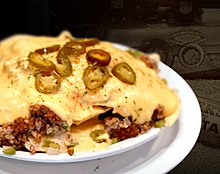User:Primapagina/Cricket Pasta
| This is not a Wikipedia article: It is an individual user's work-in-progress page, and may be incomplete and/or unreliable. For guidance on developing this draft, see Wikipedia:So you made a userspace draft. Find sources: Google (books · news · scholar · free images · WP refs) · FENS · JSTOR · TWL |

 Cricket Pasta package | |
| Course | Meal or snack |
|---|---|
| Place of origin | Thailand |
| Region or state | Bangkok |
| Created by | Bugsolutely |
| Serving temperature | Warm |
| Main ingredients | wheat flour, cricket flour |
Cricket Pasta is a fusilli pasta containing wheat and cricket flours created in 2015. It is produced by Bugsolutely Ltd., a company based in Bangkok, Thailand using a locally sourced cricket flour and Australian imported wheat flour.
History
[edit]Cricket Pasta is part of the emerging market of edible insect-based food products developed by companies like Bitty (US), Bugsolutely (TH), Chapul (US), Crobar (UK), Escobar (AU), Jimini’s (FR), EXO (US). These and other similar companies were founded between 2014 and 2016, when insects as food started emerging as a potential solution to the rising cost of animal protein, food insecurity, and environmental cost of animal factory farming (—> ), following researches from Universities like Wageningen in The Netherlands and Khon Kaen in Thailand, and especially reports from United Nation’s FAO (—> http://www.bugsolutely.com/wp-content/uploads/2015/10/FAO-book-2013.pdf. The majority of these new food products are made with crickets, especially because they are easy to farm. With 7.500 tons per year and 20,000 farmers, Thailand is one of the biggest producer of human grade crickets, according to FAO (—> http://www.fao.org/docrep/017/i3246e/i3246e.pdf). For that reason the founders of Bugsolutely has chosen Bangkok, despite the target markets being Europe and USA.
Ingredients Cricket Pasta is made of 10% semolina durum flour, 10% wheat flour and 20% cricket flour (acheta domestica ——> https://en.wikipedia.org/wiki/House_cricket powder). Compared to a pasta containing only wheat flour, Cricket Pasta has higher levels of protein, calcium, vitamin B12 and Omega fatty acid. The protein content is 12 g per serving size (55 g), which is 24% of the Daily Reference Values indicated by the USDFA. It also contains 3 g of dietary fiber per serving size, corresponding to 12% of the DRV, and 0.62 mcg of Vitamin B12 per serving size.
Edible insect legal status Entomophagy is common to cultures in most parts of South America, Africa and Asia, but it has been subject of a cultural tabu in the West. For this reason, most of the European and North American countries do not have a regulation regarding rearing, selling and importing insects as food. In order to facilitate the introduction of edible insects, on 28 October 2015, the European Parliament voted a modification to the Novel Food regulation, to allow a simplified procedure for approval from 1 January 2018 (—> http://www.bugsolutely.com/wp-content/uploads/2016/02/EU-novel-food-decision-law-8-October-2015-Novel-foods.pdf). The US FDA has defined edible insects as admissible if insects are reared specifically for human consumption. Canada not only allows entomophagy, but is home to one of the biggest cricket farm in North America (Next Millennium Farm), with a 65.000 square feet farm —> www.cnn.com/2015/07/24/world/edible-insect-food-business/.
TEXT HERE.[1]

Anaya went on to work at the Moderno Restaurant in Piedras Negras, which still uses the original recipe. He also opened his own restaurant, "Nacho's Restaurant", in Piedras Negras. Anaya's original recipe was printed in the 1954 St. Anne's Cookbook.[2][3]
The popularity of the dish swiftly spread throughout Texas and the Southwest. The first known appearance of the word "nachos" in English dates to 1950, from the book A Taste of Texas.[2] According to El Cholo restaurant history, waitress Carmen Rocha is credited with making nachos in San Antonio, Texas, before introducing the dish to Los Angeles at El Cholo Mexican restaurant in 1959.[4]
Ignacio Anaya died in 1975. In his honor, a bronze plaque was erected in Piedras Negras, and October 21 was declared the International Day of the Nacho.[1] Anaya's son, Ignacio Anaya, Jr., served as a judge at the annual nacho competition[2][3] until his death in 2010.
The International Nacho Festival is held between October 13 and 15 at Piedras Negras and features a "biggest nacho of the world" contest which is registered with the Guinness World Records.[5]
See also the common cheeses used:
TEXT HERE.
Unlike many European cheeses or certain Mexican cheeses, "nacho cheese" bears no geographical indication or other regulated guarantee of ingredients, process, or quality, beyond the general legal definition for cheese products as established by the U.S. Food & Drug Administration.
See also
[edit]Notes
[edit]- 1.^ Anaya's son, Ignacio Anaya, Jr., is quoted as saying "My father was maître d' and he said 'Let me go quick and fix something for you.' He went into the kitchen, picked up tostados,' grated some cheese on them—Wisconsin cheese, the round one—and put them under the salamander (a broiling unit that browns the top of foods). He pulled them out after a couple of minutes, all melted, and put on a slice of jalapeño."[3]
References
[edit]- ^ a b Ellerbee, Linda (2005). Take Big Bites: Adventures Around the World and Across the Table. Penguin. pp. 73–74. ISBN 978-0-399-15268-9.
- ^ a b c Cite error: The named reference
Orrwas invoked but never defined (see the help page). - ^ a b c Cite error: The named reference
haramwas invoked but never defined (see the help page). - ^ "Waitress Who Introduced L.A. To Nachos Dies". Morning Edition. October 17, 2008. National Public Radio.
{{cite episode}}: Cite has empty unknown parameter:|episodelink=(help) - ^ Mexicolesstraveled.com
Further reading
[edit]- Dunne, Mike. (January 28, 2004). "One spicy tale: 'Macho Nachos'". Sacramento Bee, p. F1.

